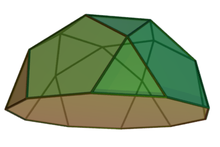| Set of rotundas | |
|---|---|
 (Example: pentagonal rotunda) | |
| Faces | 1 n-gon 1 2n-gon n pentagons 2n triangles |
| Edges | 7n |
| Vertices | 4n |
| Symmetry group | Cnv, [n], (*nn), order 2n |
| Rotation group | Cn, [n]+, (nn), order n |
| Properties | convex |
In geometry, a rotunda is any member of a family of dihedral-symmetric polyhedra. They are similar to a cupola but instead of alternating squares and triangles, it alternates pentagons and triangles around an axis. The pentagonal rotunda is a Johnson solid.
Other forms can be generated with dihedral symmetry and distorted equilateral pentagons. [example needed]
Examples[edit]
| 3 | 4 | 5 | 6 | 7 | 8 |
|---|---|---|---|---|---|
 triangular rotunda |
 square rotunda |
 pentagonal rotunda |
 hexagonal rotunda |
 heptagonal rotunda |
 octagonal rotunda |
Star-rotunda[edit]
| 5 | 7 | 9 | 11 |
|---|---|---|---|
 Pentagrammic rotunda |
 Heptagrammic rotunda |
 Enneagrammic rotunda |
 Hendecagrammic rotunda |
See also[edit]
References[edit]
- Norman W. Johnson, "Convex Solids with Regular Faces", Canadian Journal of Mathematics, 18, 1966, pages 169–200. Contains the original enumeration of the 92 solids and the conjecture that there are no others.
- Victor A. Zalgaller (1969). Convex Polyhedra with Regular Faces. Consultants Bureau. No ISBN. The first proof that there are only 92 Johnson solids.
Well, that’s interesting to know that Psilotum nudum are known as whisk ferns. Psilotum nudum is the commoner species of the two. While the P. flaccidum is a rare species and is found in the tropical islands. Both the species are usually epiphytic in habit and grow upon tree ferns. These species may also be terrestrial and grow in humus or in the crevices of the rocks.
View the detailed Guide of Psilotum nudum: Detailed Study Of Psilotum Nudum (Whisk Fern), Classification, Anatomy, Reproduction